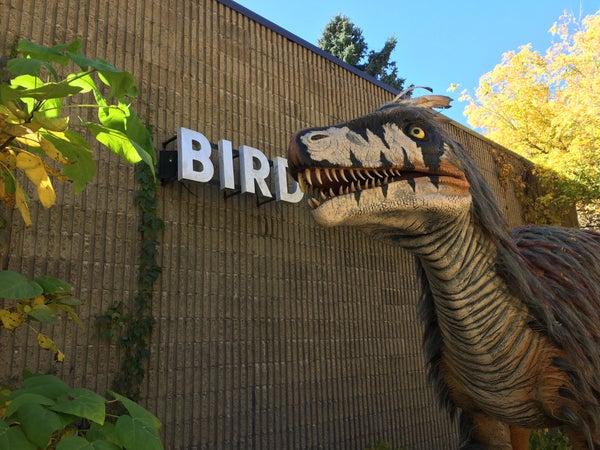This article was published in Scientific American’s former blog network and reflects the views of the author, not necessarily those of Scientific American
Picture yourself in the Early Cretaceous Period. Ahead of you, beyond the edge of an ancient forest, you see the feathery form of a Utahraptor. She’s a large one – at least twenty feet long, and tall enough to easily rest her chin on your head. Mercifully, she’s not close enough to do that. She’s simply strolling by, totally unaware of you. Then she stops. A strange look of concentration manifests across her dinosaurian features, and, in one exaggerated motion, she closes her eyes and regurgitates a brown and white mass onto the ground. It’s a pellet, the indigestible parts of her lunches over the past few days. With a snort, she stalks off after only she knows what.
We don’t know for certain whether Utahraptor ever barfed pellets like modern owls do. No one has found an appropriately-sized bolus of iguanodont and sauropod bone chunks in the Early Cretaceous strata of eastern Utah. But we know that some non-avian dinosaurs related to the famous raptors vomited pellets like modern birds do. The evidence, paleontologist Xiaoting Zheng and colleagues write, comes from the roughly 160 million-year-old strata of China.
The feathery dinosaur Anchiornis made headlines in 2009 for being an extremely close relative of the earliest known birds. Then, the next year, the dinosaur was the first to have a full color restoration based on fossil evidence. Part of the reason why is because multiple Anchiornis fossils have been found. This fuzzy flapper may be one of the best-represented dinosaurs we currently know of. And that goes for its digestion, too. As Zheng and coauthors document, at least six gastric pellets have been found in – or associated with – Anchiornis fossils.
On supporting science journalism
If you're enjoying this article, consider supporting our award-winning journalism by subscribing. By purchasing a subscription you are helping to ensure the future of impactful stories about the discoveries and ideas shaping our world today.
The oval-shaped pellets document what Anchiornis ate. This is no small thing. Paleontologists can often get a handle on what a dinosaur subsisted on from the animal’s teeth, but gut contents – especially from multiple animals – helps narrow down ancient ecology. Anchiornis seems to have been fond of small lizards and fish. Or perhaps that’s just what these individuals were able to catch.
But the pellets also tell paleontologists something about the internal anatomy and physiology of dinosaurs. Fossil feces from other theropod dinosaurs – such as allosaurs and tyrannosaurs – indicate that these carnivores pooped out indigestible material like bones. That hints that the ability to make pellets, like modern birds, was a trait that evolved closer to the ancestors of birds – among the feathery, raptor-style dinosaurs, at the latest.
The preserved pellets are also very similar to those made by modern birds, hinting that the bones and other crud that couldn’t be digested didn’t stay in the digestive tract very long. This could have been a consideration in the evolution of flight, Zheng and colleagues propose. Flight takes a lot of energy, which requires a lot of food, and so expelling indigestible material to make room for more energy-rich snacks may have been important to flapping, fluttering, flying dinosaurs. More gastric pellets from additional dinosaurs are needed to test these ideas further, but I’m still struck by the fact the dinosaurs were creating these globs back in the Jurassic. Imagine getting one in your science class, picking through the Mesozoic equivalent of the owl pellets you may have picked apart in elementary school.
